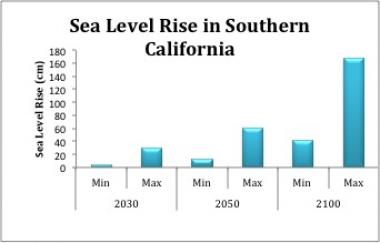
Sea level rise is one of the biggest threats to California’s sandy beaches. Rising global temperatures are causing ice caps to melt and seawater to expand, which in turn cause sea levels to rise. Because it is a complicated process, sea level rise will not occur uniformly worldwide.
The latest science predicts that sea level rise will occur at different rates in different places throughout the west coast of the United States. For Southern California, sea level rise predictions range from about 4–30 cm by 2030 to about 42–167 cm by 2100. That’s as many as 66 inches, or 5.5 feet, by 2100.
You can read more about sea level rise in California in the 2012 National Research Council report, Sea-Level Rise for the Coasts of California, Oregon, and Washington: Past, Present, and Future.
Explore how seasonal conditions and sea level rise will affect beach erosion and the beach face.
In this scenario, the cliff is a barrier to beach movement.
Credit: From "Living with Coastal Change" website, Inman et al. 2003 at SIO. Animation produced by Earthguide with support from the Kavli Foundation.
Coastal Squeeze

As sea levels rise, the ocean will slowly erode sand from many beaches along the California coast. If a beach is trapped between rising seas and coastal development, it cannot retreat inland, so it will become narrower and narrower. This “coastal squeeze” threatens beaches up and down the California coastline. The loss of beach space cuts down on recreational space for people and results in loss of habitat for many beach inhabitants, such as shorebirds, sand crabs and beach hoppers.
Nearly 60% of California’s sandy shoreline cannot migrate landward because it is bordered by man-made structures.
Beaches generally have a shallow slope; so, even a small amount of sea level rise can overtake a large portion of beach width and dramatically impact our beaches.


